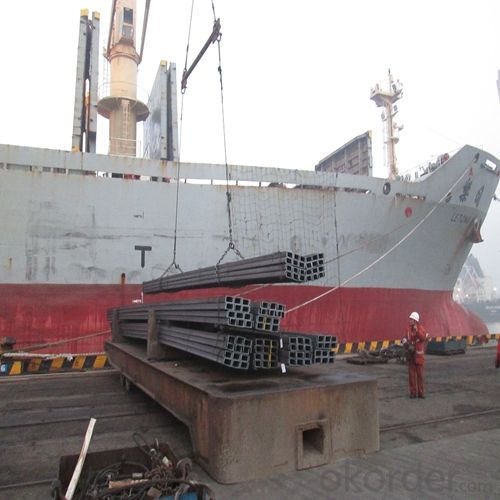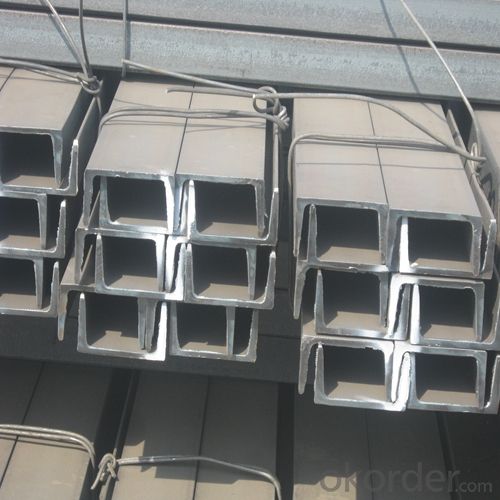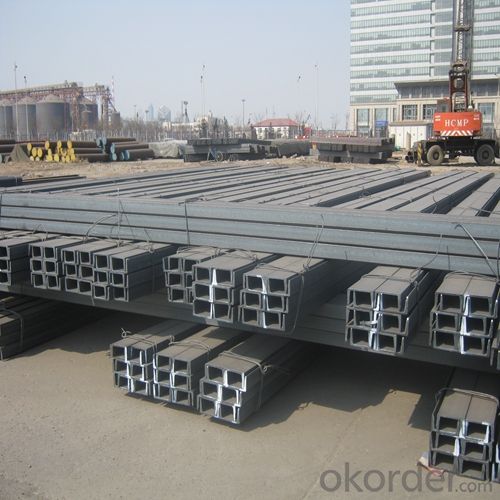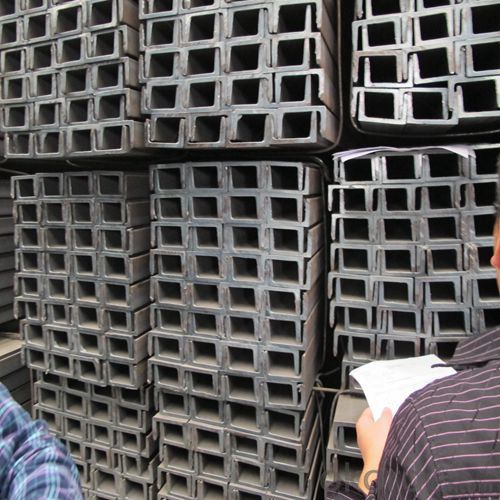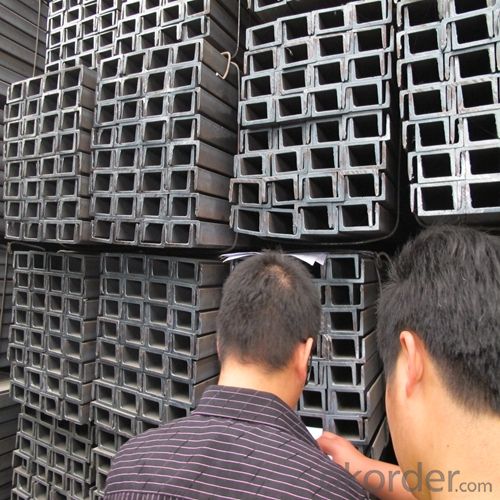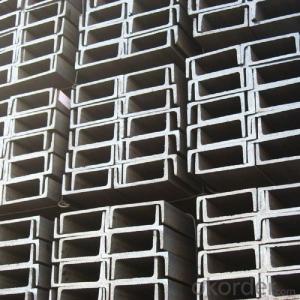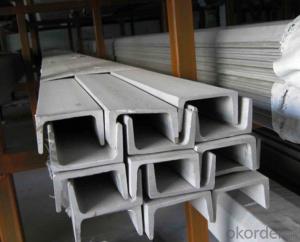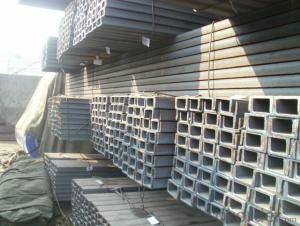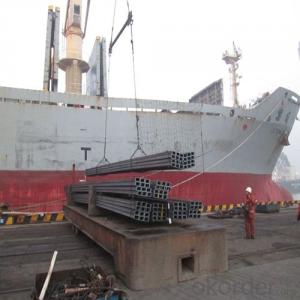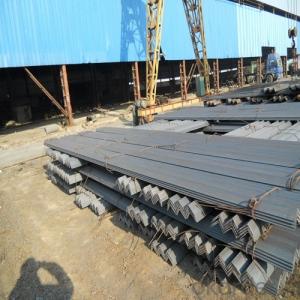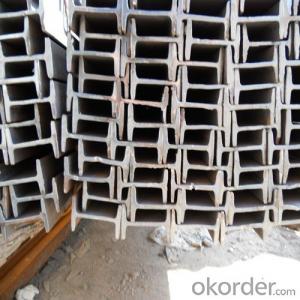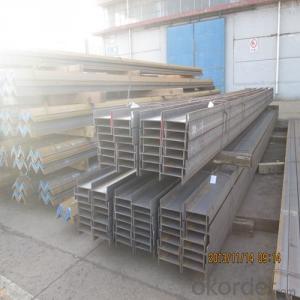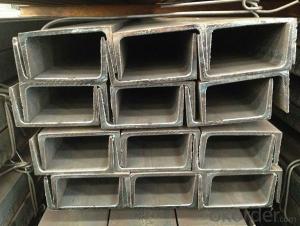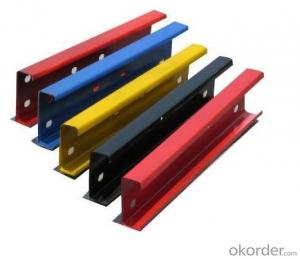H-Beam Structure Steel U-Channel JIS Standard GB Standard
- Loading Port:
- Tianjin
- Payment Terms:
- TT OR LC
- Min Order Qty:
- 100 m.t.
- Supply Capability:
- 30000 m.t./month
OKorder Service Pledge
OKorder Financial Service
You Might Also Like
Product Description:
OKorder is offering H-Beam Structure Steel U-Channel JIS Standard GB Standard Good Price at great prices with worldwide shipping. Our supplier is a world-class manufacturer of steel, with our products utilized the world over. OKorder annually supplies products to European, North American and Asian markets. We provide quotations within 24 hours of receiving an inquiry and guarantee competitive prices.
Product Applications:
Hot Rolled H-Beam Structure Steel U-Channel JIS Standard GB Standard are ideal for structural applications and are widely used in the construction of buildings and bridges, and the manufacturing, petrochemical, and transportation industries.
Product Advantages:
OKorder's H-Beam Structure Steel U-Channel JIS Standard GB Standard are durable, strong, and resist corrosion.
Main Product Features:
· Premium quality
· Prompt delivery & seaworthy packing (30 days after receiving deposit)
· Corrosion resistance
· Can be recycled and reused
· Mill test certification
· Professional Service
· Competitive pricing
Product Specifications:
JIS U CHANNEL | Standard h | Sectional b | Dimension s | t | Mass: Kg/m |
(mm) | (mm) | (mm) | (mm) | ||
50x25 | 50 | 25 | 3.0 | 6.00 | 2.37 |
75X40 | 75 | 40 | 3.8 | 7.00 | 5.30 |
75X40 | 75 | 40 | 4.0 | 7.00 | 5.60 |
75X40 | 75 | 40 | 4.5 | 7.00 | 5.85 |
75X40 | 75 | 40 | 5.0 | 7.00 | 6.92 |
100X50 | 100 | 50 | 3.8 | 6.00 | 7.30 |
100X50 | 100 | 50 | 4.2 | 6.00 | 8.03 |
100X50 | 100 | 50 | 4.5 | 7.50 | 8.97 |
100X50 | 100 | 50 | 5.0 | 7.50 | 9.36 |
125X65 | 125 | 65 | 5.2 | 6.80 | 11.66 |
125X65 | 125 | 65 | 5.3 | 6.80 | 12.17 |
125X65 | 125 | 65 | 5.5 | 8.00 | 12.91 |
125X65 | 125 | 65 | 6.0 | 8.00 | 13.40 |
150x75 | 150 | 75 | 5.5 | 7.30 | 14.66 |
150x75 | 150 | 75 | 5.7 | 10.00 | 16.71 |
150x75 | 150 | 75 | 6.0 | 10.00 | 17.90 |
150x75 | 150 | 75 | 6.5 | 10.00 | 18.60 |
Note: We are able to supply other dimensions and sizes, which depends on the customer's requirements for the quantity.
Chemical Composition of Q235B Steel U Channel:
Alloy No | Grade | Element(%) | ||||
C | Mn | S | P | Si | ||
Q235 | B | 0.12-0.20 | 0.3-0.7 | ≦0.045 | ≦0.045 | ≦0.3 |
Physical Properties of Q235B Steel U Channel:
Grade | Yielding Strength Point(Mpa) | ||||
Q235B | Thickness(mm) | ||||
≦16 | >16-40 | >40-60 | >60-100 | ||
≧235 | ≧225 | ≧215 | ≧205 | ||
Tensile Strength(Mpa) | Elongation After Fracture(%) | ||||
Thickness(mm) | |||||
≦16 | >16-40 | >40-60 | >60-100 | ||
375-500 | ≧26 | ≧25 | ≧24 | ≧23 | |
FAQ:
Q1: Why buy Materials & Equipment from OKorder.com?
A1: All products offered byOKorder.com are carefully selected from China's most reliable manufacturing enterprises. Through its ISO certifications, OKorder.com adheres to the highest standards and a commitment to supply chain safety and customer satisfaction.
Q2: How do we guarantee the quality of our products?
A2: We have established an advanced quality management system which conducts strict quality tests at every step, from raw materials to the final product. At the same time, we provide extensive follow-up service assurances as required.
Q3: How soon can we receive the product after purchase?
A3: Within three days of placing an order, we will begin production. The specific shipping date is dependent upon international and government factors, but is typically 7 to 10 workdays.
Images:
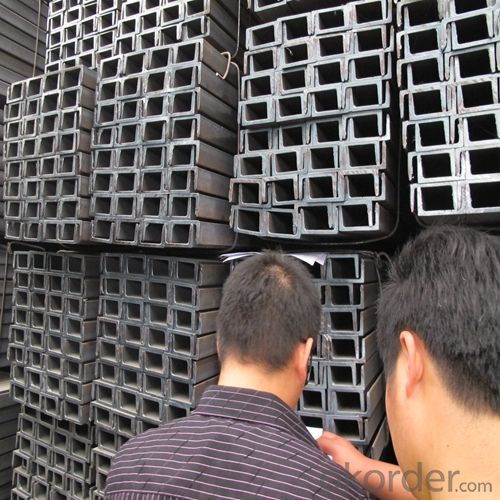
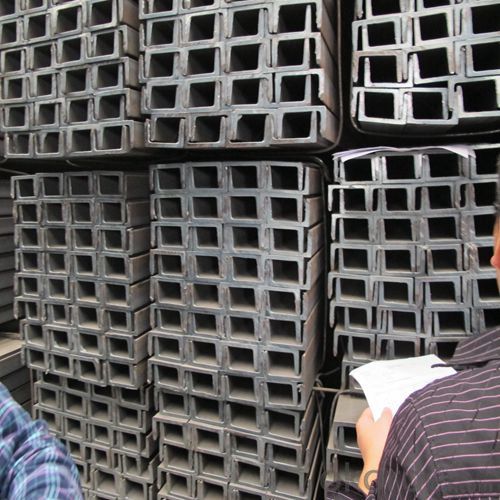
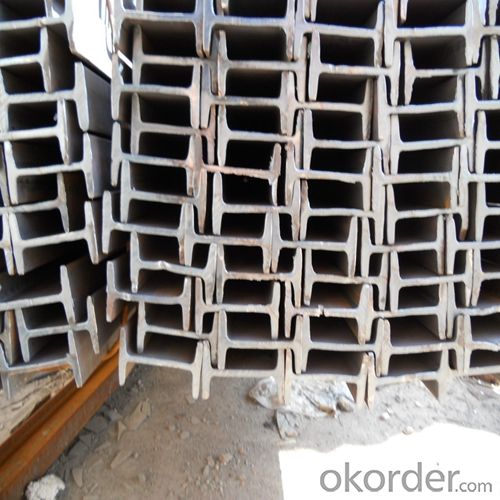
- Q: Are steel channels suitable for use in automotive applications?
- Yes, steel channels are suitable for use in automotive applications. They provide strength, stability, and durability, making them ideal for various structural and framing components in vehicles. Steel channels can withstand high loads and impacts, ensuring the safety and reliability of automotive designs.
- Q: What are the different types of surface treatments for steel channels in marine applications?
- Steel channels used in marine applications can undergo various surface treatments to enhance their durability and corrosion resistance in harsh marine environments. One commonly used treatment is hot-dip galvanizing, where the steel channel is immersed in molten zinc, forming a protective coating that acts as a barrier against corrosion caused by saltwater and other marine elements. Another option is epoxy coating, which involves applying a layer of epoxy paint to the steel channel's surface. This creates a protective barrier that prevents water and oxygen from reaching the steel, minimizing corrosion. Epoxy coatings are particularly effective in marine environments with a high risk of abrasion or impact. Apart from galvanizing and epoxy coating, other surface treatments are available for steel channels in marine applications. These include metalizing, where molten metal is sprayed onto the steel's surface to provide a protective coating, and electroplating, which involves depositing a layer of metal onto the steel using an electric current. There are also specialized marine coatings formulated to withstand the unique challenges of marine environments. These coatings may contain additives or compounds that enhance corrosion resistance and durability. Ultimately, the choice of surface treatment for steel channels in marine applications depends on factors such as the specific environment, required corrosion resistance, and budget. Consulting with a corrosion specialist or engineer is crucial in determining the most suitable treatment for a marine application.
- Q: The parameters of the channel steel of Q235B
- According to the GB/T 700-1988 GB standard, Q235B is carbon structural steel, and the grade is B,Chemical composition, mass fraction%|C:, 0.09 ~ 0.15Chemical composition, mass fraction%|Mn:, 0.25 ~ 0.55
- Q: What are the different methods of strengthening steel channels against bending?
- There are several methods that can be used to strengthen steel channels against bending: 1. Increasing the channel's cross-sectional area: One way to enhance the strength of a steel channel against bending is to increase its cross-sectional area. This can be achieved by using a thicker channel or by adding additional steel plates or sections to increase the overall area. 2. Using reinforcement plates or stiffeners: By attaching reinforcement plates or stiffeners to the weak areas of the channel, its resistance to bending can be significantly improved. These plates or stiffeners are typically welded to the channel and help distribute the applied loads more evenly, reducing the risk of bending. 3. Adding flanges or lips: Another method is to add flanges or lips to the edges of the channel. These additional sections of steel increase the stiffness of the channel, making it more resistant to bending. 4. Using bracing or truss systems: Bracing or truss systems can be employed to support the steel channel and prevent bending. These systems consist of additional steel members, such as braces or trusses, that are connected to the channel to provide additional support and distribute the applied loads. 5. Heat treatment: Heat treatment processes, such as quenching and tempering, can be used to strengthen the steel channel. These processes involve heating the channel to a specific temperature and then rapidly cooling it to increase its hardness and strength. 6. Cold working: Cold working techniques, such as cold rolling or cold drawing, can also be used to strengthen steel channels against bending. These processes involve deforming the channel at low temperatures, which increases its strength and toughness. It is important to note that the choice of method depends on various factors, including the specific application, the desired level of strength, and the available resources and equipment. Consulting with a structural engineer or steel fabrication expert is recommended to determine the most suitable method for strengthening steel channels against bending in a particular situation.
- Q: Can steel channels be used for supporting exterior cladding systems?
- Yes, steel channels can be used for supporting exterior cladding systems. Steel channels are strong and durable, making them suitable for providing structural support to the cladding. They can be used to create a framework that holds the cladding in place, ensuring it is securely attached to the building's exterior. Steel channels also offer versatility in design and can be customized to meet specific project requirements. Additionally, steel is resistant to weathering and corrosion, making it a reliable choice for exterior applications where the cladding needs to withstand various environmental conditions. Overall, steel channels are a popular choice for supporting exterior cladding systems due to their strength, durability, and versatility.
- Q: What are the different cross-sectional shapes available for steel channels?
- Steel channels, also known as C-channels or U-channels, are widely used in construction, manufacturing, and other industries due to their versatility and strength. These channels come in a variety of cross-sectional shapes, each offering unique benefits and applications. The most common cross-sectional shape for steel channels is the C-shape. C-channels have a straight back and two perpendicular flanges, creating a C-like profile. This shape provides excellent structural support and is often used in building frames, support beams, and structural components. Another popular cross-sectional shape is the U-shape. U-channels have a similar design to C-channels but feature a rounded bottom instead of a straight back. This rounded shape offers enhanced strength and is commonly used for applications requiring more load-bearing capacity, such as bridge supports and trailer frames. In addition to C and U shapes, steel channels can also be found in other cross-sectional shapes, including Z-shapes and hat channels. Z-shaped channels have two flanges that are facing in opposite directions, resembling the letter Z when viewed from the end. These channels are often used for bracing or framing applications where additional stiffness is required. Hat channels, on the other hand, have a flat horizontal top and bottom with two perpendicular sides, creating a hat-like appearance. Hat channels are commonly used as purlins for attaching roofing or cladding sheets to steel structures. Overall, the different cross-sectional shapes available for steel channels allow for a wide range of applications and provide various benefits in terms of strength, load-bearing capacity, and stiffness. The choice of cross-sectional shape will depend on the specific requirements and intended use of the steel channel in question.
- Q: What are the different types of steel channel connections for column framing?
- There are several types of steel channel connections used for column framing, including welded connections, bolted connections, and pinned connections. Welded connections involve welding the steel channels together to create a strong and rigid joint. Bolted connections use bolts and nuts to secure the channels together, allowing for easier assembly and disassembly. Pinned connections utilize pins or dowels to connect the channels, providing flexibility and allowing for relative movement between the connected members.
- Q: What are the advantages of using steel channels over other materials?
- There are several advantages of using steel channels over other materials: 1. Strength and Durability: Steel channels are known for their high strength and durability. They can withstand heavy loads and provide structural stability, making them suitable for various applications in construction and engineering. 2. Versatility: Steel channels can be easily shaped and manipulated to fit specific requirements. They can be cut, welded, and bent into different shapes and sizes, allowing for flexibility in design and construction projects. 3. Cost-Effective: Steel channels are a cost-effective choice compared to other materials like aluminum or wood. They require minimal maintenance, have a longer lifespan, and can be recycled, reducing the overall costs associated with construction and maintenance. 4. Fire Resistance: Steel channels have inherent fire resistance properties, making them a safer choice in building structures. They do not contribute to the spread of fire and provide additional time for evacuation in case of emergencies. 5. Sustainability: Steel is a highly sustainable material as it can be recycled indefinitely without losing its properties. Choosing steel channels over other materials promotes environmental conservation and reduces the carbon footprint associated with construction projects. 6. Resistance to Corrosion: Steel channels can be treated with coatings or galvanized to enhance their resistance to corrosion. This makes them suitable for outdoor applications where they might be exposed to moisture, humidity, or other corrosive elements. 7. Structural Integrity: Steel channels provide excellent structural integrity, ensuring that the components they support remain stable and secure. This is particularly important in applications where safety and load-bearing capacity are crucial, such as bridges, high-rise buildings, or industrial structures. In summary, the advantages of using steel channels over other materials include their strength, durability, versatility, cost-effectiveness, fire resistance, sustainability, resistance to corrosion, and ability to maintain structural integrity. These benefits make steel channels a preferred choice for various construction and engineering projects.
- Q: What are the different methods for protecting steel channels from UV radiation?
- There are several methods for protecting steel channels from UV radiation. One common approach is to apply a protective coating or paint that contains UV inhibitors. This helps to block or absorb the harmful UV rays and prevent them from damaging the steel. Another method is to use a UV-resistant film or wrap, which can be applied directly to the surface of the steel channel. This film acts as a barrier, shielding the steel from the UV rays. Additionally, using materials with inherent UV resistance, such as stainless steel or aluminum, can provide natural protection against UV radiation. It is important to regularly inspect and maintain these protective measures to ensure their effectiveness over time.
- Q: Can steel channels be used for supporting heavy equipment?
- Yes, steel channels can be used for supporting heavy equipment. Steel channels are commonly used in construction and industrial applications for their strength and load-bearing capacity. They are designed to provide structural support and can withstand heavy loads and forces. Steel channels are often used as beams, columns, or supports in buildings, bridges, machinery, and equipment. They are preferred for supporting heavy equipment due to their durability, stability, and ability to distribute weight effectively. However, it is essential to ensure that the specific steel channel used is appropriate for the weight and dimensions of the equipment being supported. Engineering calculations and considerations should be made to determine the suitable size, shape, and thickness of the steel channel to ensure it can adequately support the heavy equipment.
Send your message to us
H-Beam Structure Steel U-Channel JIS Standard GB Standard
- Loading Port:
- Tianjin
- Payment Terms:
- TT OR LC
- Min Order Qty:
- 100 m.t.
- Supply Capability:
- 30000 m.t./month
OKorder Service Pledge
OKorder Financial Service
Similar products
Hot products
Hot Searches
Related keywords





